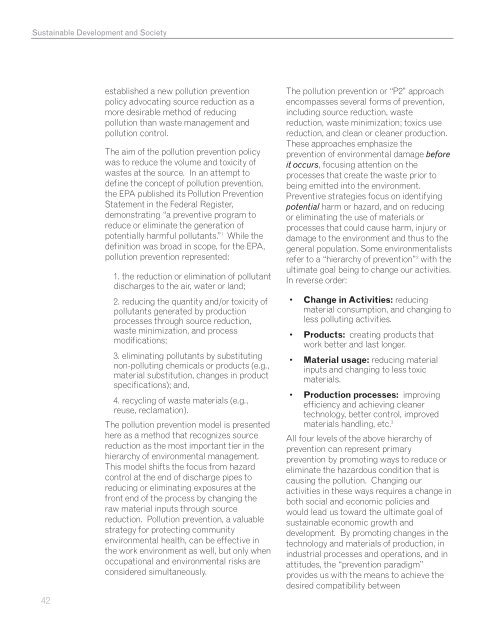Sustainable Development and Society - GSA
Sustainable Development and Society - GSA
Sustainable Development and Society - GSA
You also want an ePaper? Increase the reach of your titles
YUMPU automatically turns print PDFs into web optimized ePapers that Google loves.
<strong>Sustainable</strong> <strong>Development</strong> <strong>and</strong> <strong>Society</strong><br />
42<br />
established a new pollution prevention<br />
policy advocating source reduction as a<br />
more desirable method of reducing<br />
pollution than waste management <strong>and</strong><br />
pollution control.<br />
The aim of the pollution prevention policy<br />
was to reduce the volume <strong>and</strong> toxicity of<br />
wastes at the source. In an attempt to<br />
define the concept of pollution prevention,<br />
the EPA published its Pollution Prevention<br />
Statement in the Federal Register,<br />
demonstrating “a preventive program to<br />
reduce or eliminate the generation of<br />
potentially harmful pollutants.” 1 While the<br />
definition was broad in scope, for the EPA,<br />
pollution prevention represented:<br />
1. the reduction or elimination of pollutant<br />
discharges to the air, water or l<strong>and</strong>;<br />
2. reducing the quantity <strong>and</strong>/or toxicity of<br />
pollutants generated by production<br />
processes through source reduction,<br />
waste minimization, <strong>and</strong> process<br />
modifications;<br />
3. eliminating pollutants by substituting<br />
non-polluting chemicals or products (e.g.,<br />
material substitution, changes in product<br />
specifications); <strong>and</strong>,<br />
4. recycling of waste materials (e.g.,<br />
reuse, reclamation).<br />
The pollution prevention model is presented<br />
here as a method that recognizes source<br />
reduction as the most important tier in the<br />
hierarchy of environmental management.<br />
This model shifts the focus from hazard<br />
control at the end of discharge pipes to<br />
reducing or eliminating exposures at the<br />
front end of the process by changing the<br />
raw material inputs through source<br />
reduction. Pollution prevention, a valuable<br />
strategy for protecting community<br />
environmental health, can be effective in<br />
the work environment as well, but only when<br />
occupational <strong>and</strong> environmental risks are<br />
considered simultaneously.<br />
The pollution prevention or “P2” approach<br />
encompasses several forms of prevention,<br />
including source reduction, waste<br />
reduction, waste minimization; toxics use<br />
reduction, <strong>and</strong> clean or cleaner production.<br />
These approaches emphasize the<br />
prevention of environmental damage before<br />
it occurs, focusing attention on the<br />
processes that create the waste prior to<br />
being emitted into the environment.<br />
Preventive strategies focus on identifying<br />
potential harm or hazard, <strong>and</strong> on reducing<br />
or eliminating the use of materials or<br />
processes that could cause harm, injury or<br />
damage to the environment <strong>and</strong> thus to the<br />
general population. Some environmentalists<br />
refer to a “hierarchy of prevention” 2 with the<br />
ultimate goal being to change our activities.<br />
In reverse order:<br />
• Change in Activities: reducing<br />
material consumption, <strong>and</strong> changing to<br />
less polluting activities.<br />
• Products: creating products that<br />
work better <strong>and</strong> last longer.<br />
• Material usage: reducing material<br />
inputs <strong>and</strong> changing to less toxic<br />
materials.<br />
• Production processes: improving<br />
efficiency <strong>and</strong> achieving cleaner<br />
technology, better control, improved<br />
materials h<strong>and</strong>ling, etc. 3<br />
All four levels of the above hierarchy of<br />
prevention can represent primary<br />
prevention by promoting ways to reduce or<br />
eliminate the hazardous condition that is<br />
causing the pollution. Changing our<br />
activities in these ways requires a change in<br />
both social <strong>and</strong> economic policies <strong>and</strong><br />
would lead us toward the ultimate goal of<br />
sustainable economic growth <strong>and</strong><br />
development. By promoting changes in the<br />
technology <strong>and</strong> materials of production, in<br />
industrial processes <strong>and</strong> operations, <strong>and</strong> in<br />
attitudes, the “prevention paradigm”<br />
provides us with the means to achieve the<br />
desired compatibility between

















